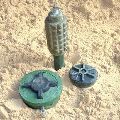Sudan mines a lurking danger for civilians, hurdle for development
KAPOETA, Sudan, Nov 27 (AFP) — A totally naked young girl, barely 10 years old, marshals a herd of goats with her crook, oblivious to the meaning of a series of red and white painted stones and a sign marked with a skull-and-crossbones.
 The meaning is danger, risk of severe injury or death. The girl is tending her flock in one of south Sudan’s countless minefields.
The meaning is danger, risk of severe injury or death. The girl is tending her flock in one of south Sudan’s countless minefields.
A few months ago, a truck blew up near here, wounding its driver.
A peace accord to end 21 years of war between the Khartoum government and the southern Sudan People’s Liberation Army might be at hand, but the vast numbers of landmines laid by both sides during the conflict are set to endanger life and limb for some time to come.
Red stones, posts and flags line the road between the Kenyan border and Kapoeta, a distance of 90 kilometres (55 miles), thanks to Mechem, a South-African based group working with the United Nations.
Since February, Mechem has disposed of some 60 mines along this road.
“Nobody told them (the local population) so far what the red and white stones mean,” according to Alison Chandler of the Mine Advisory Group (MAG), a British organisation that came to Kapoeta three weeks ago to raise awareness among local residents about the dangers posed by landmines.
“Kids use the markers as spears, the women think the red cloth can be used to dance, or take the red stones for the fire place,” explained local official Adelio Kawa.
“There should be an investigation into why the people were not educated ahead of the road reconstruction,” said Arezou Azad of the UN Mine Action Service.
Mechem and its 32 staff of mostly former soldiers use vehicle-mounted detection systems, dogs and a large vacuum cleaner-type machine to survey the road and clear it of mines.
“It took us seven months to clear up about 100 kilometres (60 miles),” explained Mechem’s Jaap Kotze.
The government and the SPLA have pledged to clinch a final peace accord by the end of the year.
The deal would open the floodgates to massive injections of aid for development and reconstruction. South Sudan, an area one-and-a-half times the size of France, needs to be built up from scratch.
Peace is also likely to prompt the return of several million refugees to their homes.
“Mines hamper the delivery of humanitarian aid because many roads were mined and abandoned. Mines delay development and reconstruction,” explained Tarcisius Nitta of the UN’s World Food Programme (WFP).
“Mines are our main problem,” said Kawa, the local official in Kapoeta.
Over the last five years in southern Sudan, landmines have injured or killed 2,500 people, according to UN figures.
Because most roads are impassable, often because of mines, the WFP flies most of its supples in, making its south Sudan operation among the most expensive in the world, where twice as much is spent on transport as is on food.
More than a million people in south Sudan are fed by the WFP, which has embarked on a programme to rehabilitate roads, with a quarter of the money going to demining.
“Demining is also essential to allow refugees to return safely,” explained MAG’s Chandler.
The war in southern Sudan has displaced some four million people and claimed 1.5 million lives.
A million are expected to return home next year
alone.
According Nitta, “if the region is demined, it will need less food aid, because people will be able to farm and start building safely.
“When we get rid of the mines, that will really be the end of the war,” said Jurkuch Barach, a former SPLA commander now heading a major demining agency.
